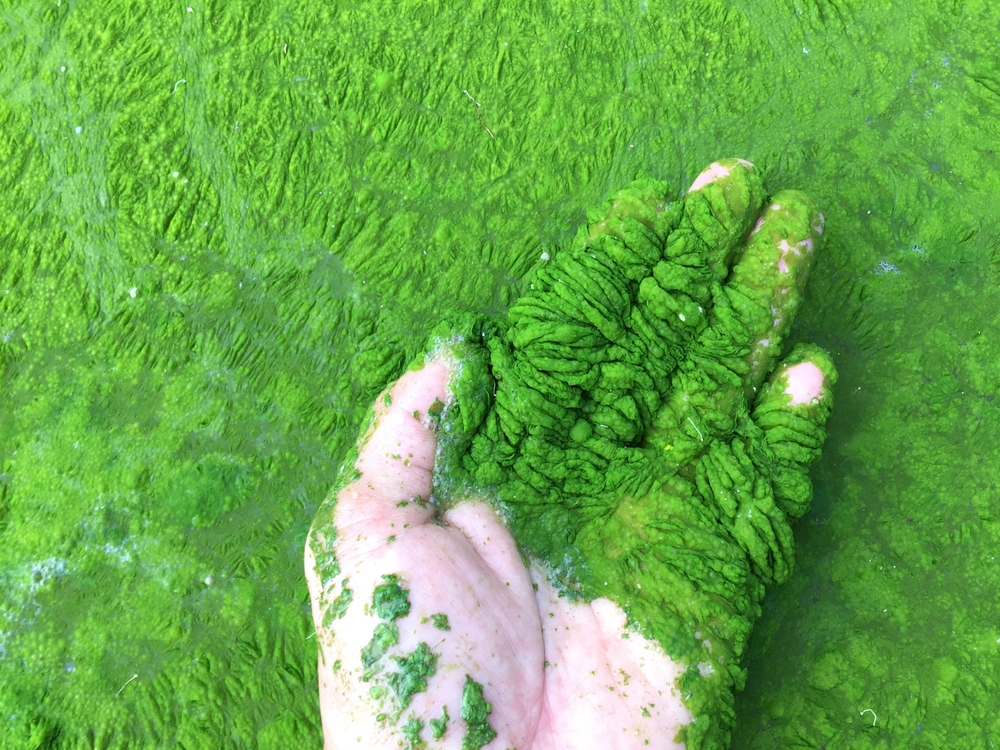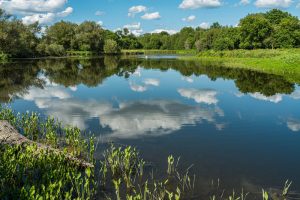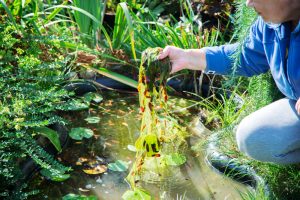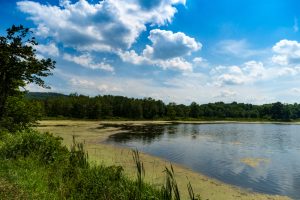Is your pond or lake accumulating a thick, green layer on its surface? This could be an algae bloom. While algae blooms are a natural occurrence, especially in the warm areas around Houston, they do not make a beautiful view. Discover what causes algae blooms in ponds and how you can treat it with bio-safe chemicals.
What Causes Pond Algae? How Do You Treat It?
Pond and lake algae can be harmful to a pond’s ecosystem, especially if it gets out of control. Algae blooms are often the most prevalent in warmer climates and slow-moving or stagnant water. This causes the pond to have a thick, soupy green color and even can make the pond smell. We recommend adding safe chemical treatments to help the pond thrive for plants, animals, and any other visitors.
What Causes Algae Blooms?
There are several possible causes of algae blooms in ponds in the Houston area. These include runoff of phosphorus, decomposition of weeds, and/or stagnant water.
The runoff of phosphorus and nitrogen-based nutrients creates excess nutrients that can trigger algae blooms. When these nutrients accumulate in high concentrations, they cause the rapid growth of algae blooms and other aquatic plants.
The decomposition of weeds, leaves, trees, and other organic matter in water bodies fosters the growth of bacteria. Their chemical composition consumes oxygen during decomposition, creating a myriad of consequences This oxygen depletion challenges the survival of fish, insects, and other aquatic organisms.
Optimal conditions for algae blooms include calm, slow-moving, or stagnant water, particularly in warmer weather and water temperatures. The excessive algae growth can visibly tint the water green, although it can also cause other hues of red, brown, and yellow. In addition, certain algae species form clumps enveloped in a gelatinous coating and are capable of aggregating into large surface scums.
Where is Algae Most Commonly Found?
During warmer seasons, algae blooms frequently emerge in stormwater ponds. These types of ponds capture polluted runoff and are specifically engineered to detain such contaminants. By doing so, stormwater pondsaid in the removal of nutrients and sediments, preventing these pollutants from reaching delicate water ecosystems.
Apart from stormwater ponds, algae blooms can proliferate in lakes, farm ponds, and coastal waterways. Essentially, any stagnant water body located near sources of nutrient and sediment-laden runoff holds the potential to harbor algae blooms.
How Long Will an Algae Bloom Last?
Algae blooms don’t go away as easily as a pond owner might hope. In warmer climates like here in Texas, harmful algae blooms will stay and continue to grow. Favorable conditions include warm weather, sunlight, and low flow rates. Blooms can last from weeks to months and it is difficult to predict when they will clear.
While having algae blooms in your pond may seem like a problem, not all algae blooms are bad. For example, blue-green algae can help increase oxygen levels in a body of water because of the nutrients entering the pond. They can help improve the natural ecosystem in a pond.
With that being said, too much algae can cause damage to your pond or lake. Get in touch with a professional to understand what your pond needs and whether it requires treatment.
How to Treat Algae Blooms
There are several ways to treat algae blooms in ponds or other bodies of water. These treatment methods include growing other kinds of plants, adding manual filters, and/or manually cleaning your pond with machine equipment.
One of the most effective methods of algae treatment is through chemicals. Chemical pond treatments can provide quicker results than most biological methods. In addition, ey can be less harsh on the environment than using heavy equipment.
Many chemical treatments can target a wide range of algae species. While most of these chemicals are safe for many ponds, it is important to have your pond professionally inspected to receive the best care and maintenance.
In some instances, adding the wrong chemical to a pond can be ineffective in combating the specific type of algae. It can even cause harm to other plants and wildlife.
How to Prevent Algae Blooms
One of the best ways to prevent algae growth is to have ponds regularly checked and serviced by a professional. Pond cleaning and maintenance services provide routine maintenance, testing, and preventative maintenance to help your pond or lake look its best. It’s our goal to ensure a healthy ecosystem by using safe and non-harmful treatments for your pond.
At Waterline, we understand the delicate balance required to maintain a vibrant and thriving pond or lake. By incorporating these chemical treatments into our maintenance service, we ensure that your pond is beautiful and healthy year-round.
Ready to Get Rid of Excessive Algae Growth?
If you are ready to get rid of the algae on your pond or lake or are interested in taking preventative measures, consider partnering with Waterline to keep your pond in its best condition. Our commitment to utilizing environmentally friendly solutions emphasizes our dedication to preserving the natural beauty of your pond while effectively combating algae blooms.
Contact our experts today to get your pond on the right track and keep it clean year-round.



